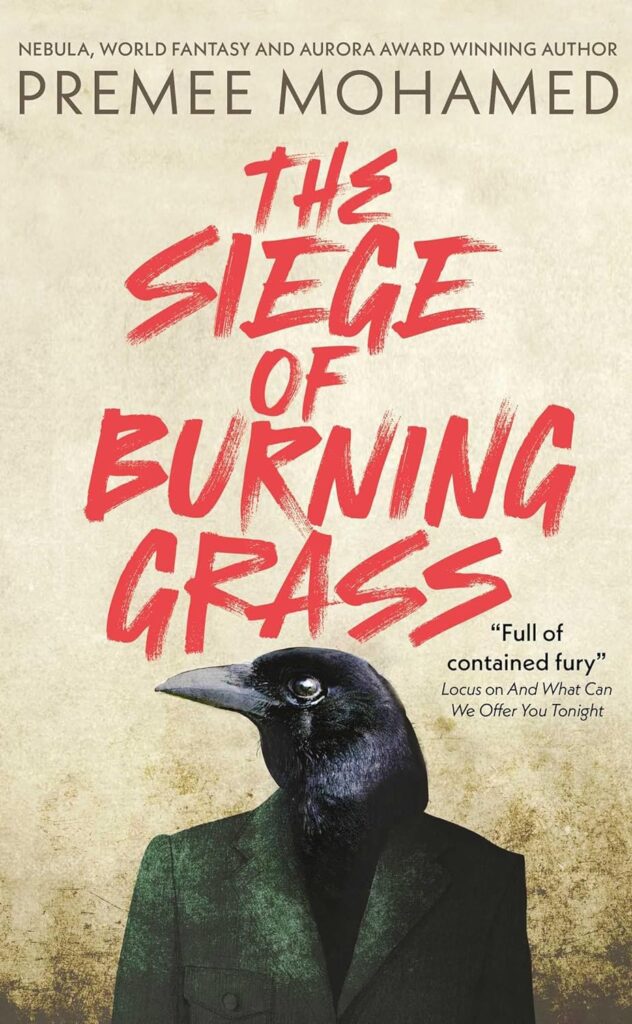During the recent Coode Street podcast interview with Premee Mohamed, she came up with an interesting phrase that seemed to capture what happens in her latest novel, The Siege of Burning Grass. She said that while juggling all the demands on her time, she often felt like one of her characters being “seduced into usefulness.” That’s exactly what happens to Alefret, the protagonist of the novel, when he, a giant of a man who is also a leader of a rigorously pacifist group and imprisoned during wartime, agrees to a strange assignment. He is to go behind enemy lines and find a way to end the war, and he is to be accompanied by his cut-throat torturer, Corporal Qhudur, who sees him as a monster.
The Siege of Burning Grass is a secondary world fantasy about the war between the Varkal and the Meddon. It’s a war fought mostly with bombs, pteranodons trained as bomber planes, guns and knives, and the Meddon have managed to turn their capitol city into a flying fortress. It’s a type of anti-war near-fable that kept reminding me of Dino Buzzati’s The Tartar Steppe, but it has its own mesmerizing and disquieting beauty.
In Alefret, Mohamed has created an amazing figure, a man who, we find out eventually, is over seven feet tall with a massive build that could enable him to kill his captor with his bare hands. Yet he is also a key signer of a document called the Pact, which commits him and its many followers to absolute non-violence. He is “seduced” into accepting this plan of infiltrating Meddon in the company of his torturer, even though he has little idea what it might entail or require him to do. He is focused entirely on the remote chance that it could bring an end to the war and save millions of lives, though quite likely, he thinks, at the cost of his own.
The story has a straightforward structure in five parts. There is a brilliant first section at the prison where Alefret is kept and tortured. Then there are sections on the painful march across open country by Alefret and Qhudur to get to the main military camp of Varkal; their arrival at that camp and preparation for carrying out the plan; their landing in the flying Meddon city and meeting the Meddon resistance; and the exciting implementation of the plan to end the war. The writing is precise and evocative throughout, as each setting and character Alefret meets comes to life.
The opening scenes are unforgettable. Alefret is a prisoner in a former corrective school for young people, but it’s built like a conventional prison and probably offered little chance for reform to its previous inmates. He can see into a courtyard where each day other prisoners are executed by having their throats cut. During his regular interrogation and torture sessions, his captors demand he write down the names of his accomplices and the types of information they believe, falsely, he has been sending to the enemy. Alefret adheres to the principles of the Pact which won’t allow him to offer any form of support to the war, however indirect.
Before his capture, Alefret lost one of his legs in a bombing raid, and this has led to his becoming an experiment in limb regeneration carried out by a mad doctor. This treatment consists of the regular injection by means of wasps of various chemicals that, the doctor believes, are causing the tissues of his leg to grow back. The wasps live in a box hanging from the ceiling of his room, and the only grisly relief they offer is an occasional jab of anesthetic to relieve the pain in the stump of his leg.
One day a new person walks into his cell along with Qhudur. She is a general, perhaps in her seventies, with a severely beautiful face, her uniform covered with medals.
“He met her eyes, the brass buttons of a raptor, and looked down again, not feeling as if he had actually managed to drop his gaze. Her eyes were sewn all over her coat, and continued to watch him. Her voice was smooth, even musical: the flute that plays the menacing counterpoint in minor key when the song about the wolf is sung around the fire.”
The Siege of Burning Grass, Advanced Review Kindle Edition, Loc 239
Here is the siren who will persuade Alefret to stretch his principles to include the foray behind “enemy” lines. What he cannot get out of his head is the possibility that so many lives could be saved if only the war would end. So he agrees to participate in this strange effort to have two people, as ill-matched as one could imagine, to end a war all by themselves. He sets off with Qhudur. We are kept in the dark about what this seemingly impossible plan might actually entail, as is Alefret. He just keeps reminding himself of all the lives that will be saved and seems resigned to losing his own. So, while he remains in some ways a prisoner, he also becomes an accomplice of the deadly Qhudur and the Varkal war machine.
Corporal Qhudur, his constant companion, is himself a killing machine with a supply of knives hidden in various parts of his clothing. He can whip them out and kill anyone who gets in their path. He is forever reminding Alefret that he would like nothing more than to cut his throat, since he sees him as a physical and moral monster for failing to defend his country. Though he is almost always with Alefret, Qhudur remains strangely faceless to me, and all the more frightening, especially as he berates his prisoner/accomplice for moral failings. For him, as for the Varkal propaganda machine, words are weapons designed to prepare people to kill or be killed. The Meddon propaganda has done the same for its side, convincing its people of the barbaric inhumanity of their terrible opponents.
The Siege of Burning Grass is a penetrating look at war, its victims and perpetrators, and the moral complexity of a physically powerful man whose principles compel him to contain the force he could so readily use to destroy his tormentors. This is not an easy book to read but one that is beautifully written and impossible to forget.
My thanks to Rebellion Solaris and Net Galley for an advance copy of The Siege of Burning Grass for this review, which reflects solely my own opinions.





Leave a Reply